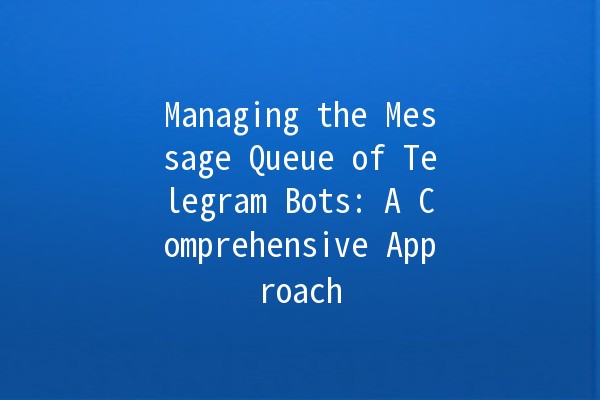Managing the Message Queue of Telegram Bots: A Comprehensive Approach

In the world of instant messaging, Telegram has carved a niche for itself with its robust features and flexibility. One of the most compelling features of Telegram is the ability to create and manage bots, which can significantly enhance user interaction and automate various tasks. However, just like any other application, managing the flow of messages through these bots is crucial to ensuring their effectiveness. This article delves into the intricacies of managing the message queue of Telegram bots, covering essential aspects such as message processing, performance optimization, and best practices.
Understanding Telegram Bots
Before diving into message queue management, it is essential to understand the fundamentals of Telegram bots. Essentially, a Telegram bot is a thirdparty application that runs on Telegram's platform, allowing users to interact with it through messages. Bots can perform a wide array of tasks, from providing customer support to automating workflows and delivering news updates.
To create a Telegram bot, developers need to interact with the Telegram Bot API, which offers various methods for sending messages, managing chats, and receiving updates. Each interaction generates messages that need to be queued for processing, and managing this queue efficiently is key to providing a seamless user experience.
The Importance of Message Queue Management
Effective message queue management is crucial for several reasons:

The Basics of a Message Queue
A message queue is a data structure that stores messages sent to the bot until they are processed. Here’s a brief overview of how a message queue functions:
Message Arrival: As users interact with the bot, messages are pushed into the queue.
Processing Messages: The bot picks messages from the queue and processes them in a firstin, firstout (FIFO) order.
Response Generation: After processing, the bot generates a response, which is then sent back to the user.
Error Handling: If an error occurs during processing, the message can be retried or logged for further analysis.
Designing a Message Queue System
Choosing the Right Queue Implementation
When designing a message queue system, selecting the right technology is pivotal. Options include inmemory queues (like Redis) and persistent message brokers (like RabbitMQ or Kafka). The choice largely depends on the expected volume of messages and the application’s architecture.
Setting Up the Queue Structure
Once a queuing mechanism is selected, defining a structure to manage messages is the next step. This often includes categorization of messages based on their priority or type. A typical structure may include:
Message ID: Unique identifier for each message.
User ID: Identifier for the user sending the message.
Content: The actual text or data contained in the message.
Timestamp: Time at which the message was received.
Handling Incoming Messages
Webhooks vs. Polling
Two primary methods allow your bot to receive incoming messages: webhooks and polling.
Message Filtering and Routing
Not all messages received by the bot require immediate attention. Implementing a filtering system allows the bot to classify messages based on criteria such as:
User Type: Differentiating between regular users and admins can help prioritize tasks.
Urgency Level: Messages that are timesensitive should be processed first.
Content Type: Different handling for inquiries, commands, or casual interactions.
Processing Messages from the Queue
Asynchronous Processing
Using an asynchronous approach allows the bot to process multiple messages simultaneously. This can significantly speed up response times and reduce user wait time. Techniques like async/await in programming languages facilitate this model.
Task Distribution
For bots handling high traffic, distributing tasks among multiple instances can balance the load. This approach evenly spreads the workload, ensuring no single instance is overwhelmed.
Error Handling and Retries
Inevitably, some message processing will fail due to various issues, such as API errors or network problems. Implementing a robust error handling strategy is crucial:
Retry Mechanism: Automatically retry processing failed messages after a set duration. Implement exponential backoff to avoid overwhelming the system.
Dead Letter Queue: Messages that fail repeatedly can be sent to a dead letter queue for further inspection and resolution.
Optimizing Performance
Monitoring Message Throughput
To manage and improve message queue performance, it’s essential to monitor throughput—the rate at which messages are processed. Tools like Grafana, Prometheus, or builtin monitoring solutions in message brokers can provide insights into system performance.
Scaling the Queue
As usage grows, scaling the message queue might be necessary. Depending on the queuing technology chosen, this could involve:
Vertical Scaling: Increasing the resources (CPU, memory) allocated to the existing message broker.
Horizontal Scaling: Adding more instances of the message broker and distributing the load among them.
Caching Responses
For repetitive queries or actions, caching responses can save time and resources. A caching layer can store responses to frequently asked questions, significantly speeding up response times.
Best Practices for Managing Telegram Bots
Limit Message Length: Users tend to lose interest in longer messages. Keeping responses concise enhances engagement.
Regular Updates: Regularly update the bot’s code and libraries to ensure security and performance.
User Feedback Loop: Encourage users to provide feedback on their experiences, enabling continuous improvement.
Rate Limiting: Implement rate limiting to prevent abuse and ensure fair access for all users.
Managing the message queue of Telegram bots is a critical aspect of ensuring their success and efficiency. By implementing a robust queuing system, streamlining message processing, and following best practices, developers can create bots that handle large volumes of messages without compromising performance. The future of Telegram bots is bright, and with the right management strategies in place, they can truly shine in enhancing user engagement and automating tasks. As technology continues to evolve, staying updated with the latest techniques and methodologies in message queue management will help developers create even more responsive and userfriendly bots.
Other News

如何在TelegramX中进行群组投票 🤖📊

Telegram安装时间优化 🚀📱

Telegram Mac版下載地址及其特色功能探索!
